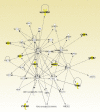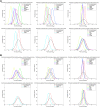Transcriptional network predicts viral set point during acute HIV-1 infection
- PMID: 22700869
- PMCID: PMC3534464
- DOI: 10.1136/amiajnl-2012-000867
Transcriptional network predicts viral set point during acute HIV-1 infection
Abstract
Background: HIV-1-infected individuals with higher viral set points progress to AIDS more rapidly than those with lower set points. Predicting viral set point early following infection can contribute to our understanding of early control of HIV-1 replication, to predicting long-term clinical outcomes, and to the choice of optimal therapeutic regimens.
Methods: In a longitudinal study of 10 untreated HIV-1-infected patients, we used gene expression profiling of peripheral blood mononuclear cells to identify transcriptional networks for viral set point prediction. At each sampling time, a statistical analysis inferred the optimal transcriptional network that best predicted viral set point. We then assessed the accuracy of this transcriptional model by predicting viral set point in an independent cohort of 10 untreated HIV-1-infected patients from Malawi.
Results: The gene network inferred at time of enrollment predicted viral set point 24 weeks later in the independent Malawian cohort with an accuracy of 87.5%. As expected, the predictive accuracy of the networks inferred at later time points was even greater, exceeding 90% after week 4. The composition of the inferred networks was largely conserved between time points. The 12 genes comprising this dynamic signature of viral set point implicated the involvement of two major canonical pathways: interferon signaling (p<0.0003) and membrane fraction (p<0.02). A silico knockout study showed that HLA-DRB1 and C4BPA may contribute to restricting HIV-1 replication.
Conclusions: Longitudinal gene expression profiling of peripheral blood mononuclear cells from patients with acute HIV-1 infection can be used to create transcriptional network models to early predict viral set point with a high degree of accuracy.
Conflict of interest statement
Figures



References
-
- Mellors JW, Rinaldo CR, Jr, Gupta P, et al. Prognosis in HIV-1 infection predicted by the quantity of virus in plasma. Science 1996;272:1167–70 - PubMed
-
- Kuroda MJ, Schmitz JE, Charini WA, et al. Emergence of CTL coincides with clearance of virus during primary simian immunodeficiency virus infection in rhesus monkeys. J Immunol 1999;162:5127–33 - PubMed
-
- Schmitz JE, Kuroda MJ, Santra S, et al. Control of viremia in simian immunodeficiency virus infection by CD8+ lymphocytes. Science 1999;283:857–60 - PubMed
Publication types
MeSH terms
Substances
Grants and funding
LinkOut - more resources
Full Text Sources
Medical
Research Materials
Miscellaneous

